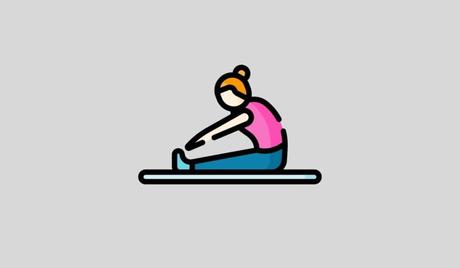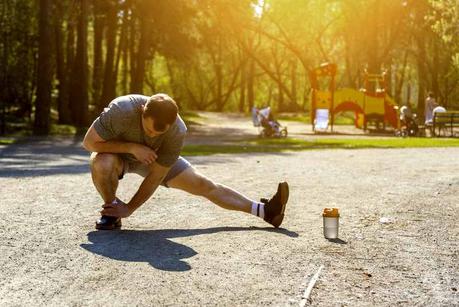Wondering if stretching can play a role in your weight loss goals? Absolutely–here’s how many calories each type of stretching burns, as well as how to do it for maximum fat burning.

Stretching is such an important part of your workout!
As we’ve seen many times before (including in my “does stretching build muscle” article) regular stretching is crucial for improving your fitness.
It not only decreases your chance of injuring yourself, but it increases muscle growth and enhances your agility.
Basically, if you want to be fit, you have to take the time stretch before and after your training sessions.
But a lot of people wonder, “Does stretching burn calories? Will spending the time warming up and cooling down help to boost my metabolism and increase energy expenditure?”
In this post, I’ll answer this question, taking a look at the various types of stretching, examining how many calories are burned, and finally explain how you can use stretching to achieve your weight loss goals.
By the end, you’ll know exactly what you need to do to increase your fitness and calorie-burning by spending time stretching daily.
Let’s jump right in.
Stretching – Overview
Stretching is defined as1 “a form of physical exercise in which a specific muscle or tendon is deliberately flexed or stretched in order to improve the muscle’s felt elasticity and achieve comfortable muscle tone.”
The time you spend stretching offers a number of crucial benefits. Some of those benefits of stretching include:
Better muscle control. With a greater range of motion and increased flexibility, you have greater control over the way your muscles move and your body reacts to that movement.
Reduced pain and tension. Stretching loosens up your connective tissue and muscles, which in turn helps to alleviate tension caused by inactivity (when the muscles tighten up on their own) or pain caused by post-workout or post-injury stiffness.
Facilitate movement. When you spend all day being inactive or sitting down, your muscles tend to tighten up and shorten. This reduces their effective range of motion when the time comes to exercise. Not only does this contribute to muscle weakness, but also increases your risk of injury. Stretching facilitates natural movement by elongating and loosening up your muscles.
Prevent injuries. Tight, stiff muscles and connective tissue (tendons and ligaments) are more likely to tear or snap when placed under pressure, particularly if they are “cold” and stiff. Stretching helps to warm up that tissue and increase elasticity, which in turn decreases the risk that you’ll injure yourself when you run, jump, or lift heavy objects.
There are always the benefits of growing more flexible over time, but at the end of the day, the primary benefits of spending time stretching revolve around your overall athletic performance.
See also: Full Body Stretching Routine: Benefits, Step-by-Step Instructions, and More
Taking the time to stretch is absolutely crucial for improving your ability to move easily, naturally, and safely.

The Different Kinds of Stretching
Before we talk about how many calories you burn by stretching, it’s important to understand that there are a number of different types of stretching—and they’re not all the same!
Some are far more active (meaning they burn more calories), while others move at a slower pace and thus don’t burn as many calories.
Here are the types of stretching you need to know about:








How Many Calories Do You Burn Stretching?
There are really two answers to this question…and you’ll see why in just a minute.
If you looked up “How many calories do you burn stretching?” the answer is likely to be along the lines of “between 4 and 6 calories per minute” (according to the experts at Harvard Health).
Within a 30-minute stretching workout:
- A 125-pound person will burn around 120 calories (4 per minute)
- A 155-pound person will burn around 144 calories (4.8 per minute)
- A 185-pound person will burn around 168 calories (5.6 per minute)
That’s not a lot, is it?
See also: 5 Best Quad Stretches for Increased Flexibility and Performance
That’s because the answer is looking at the slower-paced types of stretching, including passive, static, isometric, and PNF stretching.
But what happens if you get more active with your stretching session? With active stretching, you engage your muscles to hold the stretched position.
Looking for a stretching program that can help you along your stretching journey? Hyperbolic Stretching, a digital and guided stretching program, has a TON of different routines to help. Here’s a closer look at this program in my full review of Hyperbolic Stretching.
With dynamic stretching, you’re actually moving through a specific range of motion (such as squatting, lunging, swinging your arms, etc.). That’s not the calm, slow-pace type of stretching that burns so few calories!
With active and dynamic stretching, you can burn more calories per minute than you would with the slower-paced types of stretching.
It’s roughly on par with a moderate-paced calisthenics workout, which, with 30 minutes of training:
- A 125-pound person will burn around 135 calories
- A 155-pound person will burn around 162 calories
- A 185-pound person will burn around 189 calories
See the difference there?
It’s not huge—you’re not going to torch insane amounts of calories or fat just by being more active in your stretching—but it can make enough of a difference that you’ll A) feel more “warmed up” and ready for your workout while B) burning more calories.
How to Use Stretching to Achieve Your Weight Loss Goals
If your goal is to lose weight, it’s always worth taking the time to engage in those upper body, back, core, and leg stretches before and after training.
Stretching is crucial for your fitness on every level. Though it may not burn as many calories as the rest of your training, it’s what helps you get through the rest of your training session safely and effectively.
Think of it as the “gateway to weight loss”!
To see serious weight loss:
- Start every training session off with a stretching warm-up. Mix together static and dynamic stretches, active and passive stretches, isometric and PNF stretches in whatever combination works best for you. Try all the variations on stretching to get a sense of how well they loosen your body and relax your muscles. It’s worth experimenting with the various types of stretching to find the options that work most effectively for each part of your body and for each workout you’ll be doing.
- Hit the training hard. Once you’re done stretching, hit your workout at MAX intensity. Lift those weights, run that trail, or cycle your heart out. Whatever exercise you’re doing, give it your all and push to BURN THOSE CALORIES!
- Cool down with more stretches. Now that you’ve pushed your muscles to their limit, it’s time to loosen them up and help them relax with more stretches. Again, mix and match the various types of stretching to find the cool-down that helps to prevent soreness, stiffness, and pain following your training session.
- Stretch all day long. Throughout the day, make it a point to spend more time stretching. When sitting down, stretch your hands and legs. Stand up every hour for a bent-over glute stretch or a raise-up-on-your-tiptoes back stretch. When watching TV or reading in the evenings, rather than just lounging on your couch, assume a position that helps to stretch out your muscles. The more you stretch, the more mobile and agile you will be!
- Stretch to relax. Whenever you feel stressed, tired, or achy, spend a few minutes stretching. You’ll find it does wonders to center your mind, regulate your breathing, and loosen the tension in your body.
Getting in the fitness mindset by stretching throughout the day will help you to be more active overall and keep you from settling into a sedentary lifestyle.
That’s the key to seeing the weight loss results you want sooner rather than later!
The Bottom Line
No fitness program is complete without daily/regular stretching!
Pushing hard to build muscle and lose weight will only improve one aspect of your fitness; if you’re stiff, inflexible, and unable to move easily and naturally, you won’t truly be “fit”.
No matter where you are on your fitness journey—just starting out, somewhere in the middle, or approaching the pinnacle of excellence—it’s just as important that you spend time stretching and loosening up your muscles!
More Stretching Guides Like This
Stretching Routine for Front Splits: Stretches, Tips, and Step-by-Step Instructions. Master the front splits with this stretching routine that you can do anywhere. Includes step-by-step instructions, muscles stretched, safety tips, and more.
The Best Stretching Programs and Apps for Improving Flexibility. Looking for a stretching program or app to help you kick up your flexibility? Here’s a detailed look at the top stretching apps for every level of user.
